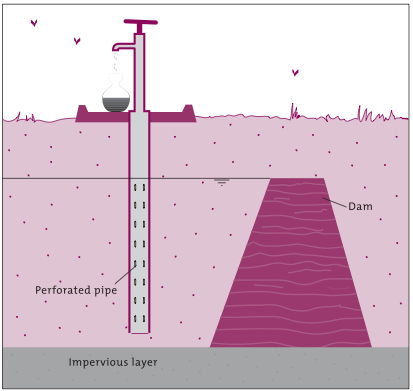Subsurface harvesting systems
The use of subsurface dams in naturally occurring alluvium creates groundwater storage upstream of the dam, raising the water table and preventing evaporation losses. These are structures that reduce or stop the flow of shallow groundwater. A subsurface dam is constructed across a valley in a seasonally dry, sandy riverbed, by digging a trench down to the bedrock or other impervious layer (clay) at the base of the river. The dam, which is placed in the trench, may consist of a wall or screen and covered with excavated material until it is completely concealed. The refill material must be properly compacted. There are two types of groundwater dams: a subsurface dam (which is explained here) and a sand dam. A subsurface dam is the one easier to build of the two. The structure is built inside an existing riverbed, so that after a flooding event, for example, water is increased due to a new and higher water level within the sand.
Contents
Suitable conditions
- Siting requirements are similar to the sand dam.
- Subsurface dams should be built where sand volume is already sufficient to store water.
- Seasonal rivers in semi-arid regions with permeable sediments and an impervious layer at a shallow depth (maximum 3 to 4m deep).
- River valleys with gradients of between 1 and 2% usually enable the highest storage.
- Ideal where groundwater flow converges from a large catchment into a narrow passage.
| Advantages | Disadvantages/limitations |
|---|---|
| - Subsurface dams are not likely to deteriorate, with little danger of breaching - Construction has long lifespan and require minimal maintenance |
- Leakage is often difficult to detect - Downwater flow will be impacted to communities downstream |
Construction, operations and maintenance
- Build the crest of the underground dam at least 1 metre beneath the ground surface, so the land does not become water-logged.
- Subsurface dams should have wing walls, just like a sand dam does, where you can pile up rocks so that erosion does not occur.
- Water can be abstracted by a well a short distance up- stream of the dam, or by a drain system which collects water from the upstream base of the dam and leads it to the downstream side to a well or gravity-pipe system.
- Where possible, a flushing valve is installed to facilitate cleaning of the subsurface reservoir.
Costs
- Materials costs and construction: US$1,400
- Feasibility study: US$200
- Technical support: US$275
- Operation and maintenance: low
Field experiences
A subsurface reservoir in Pernambuco, Brazil has an average depth of 4m, is 50m wide, and 500m long, storing about 4,000m3 of water.

